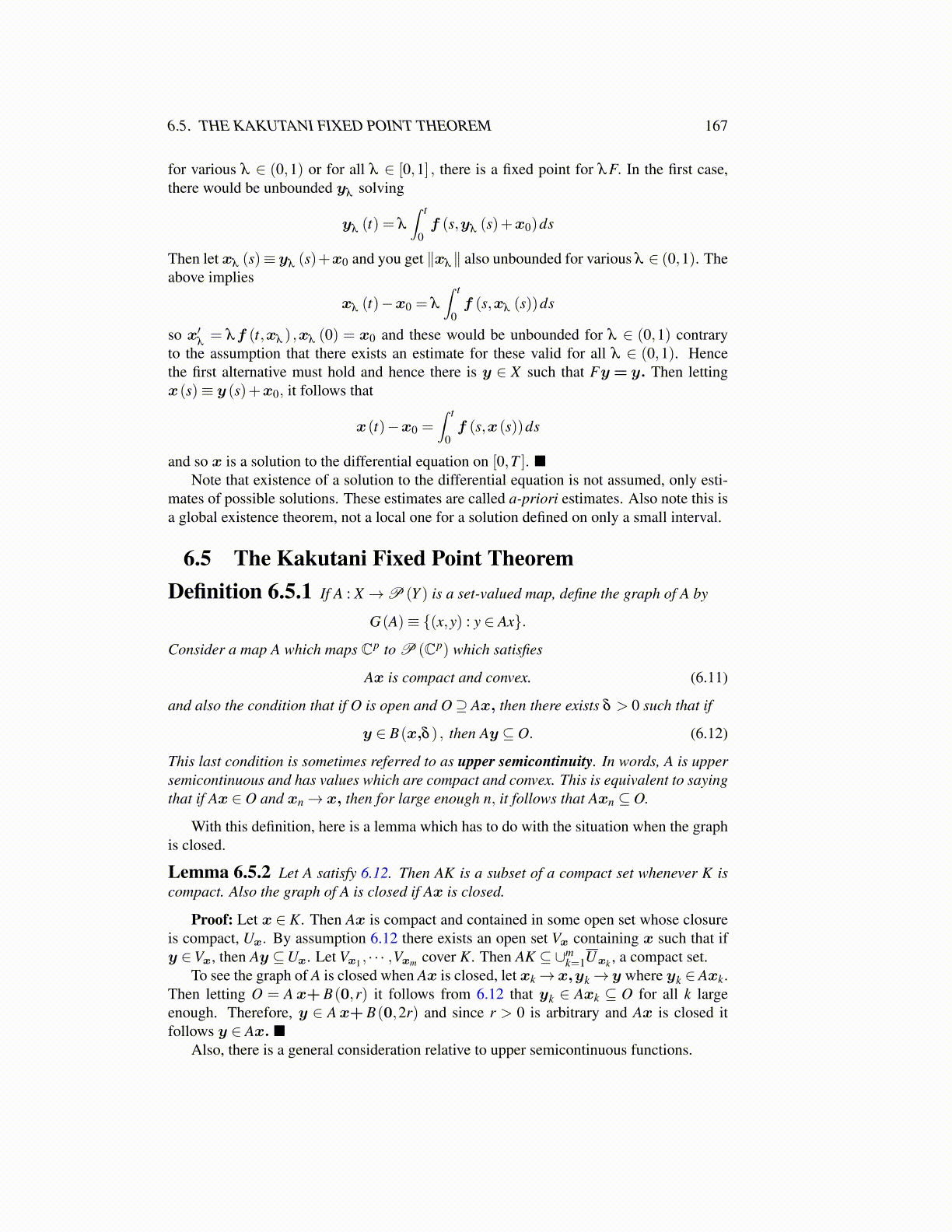
6.5. THE KAKUTANI FIXED POINT THEOREM 167
for various λ ∈ (0,1) or for all λ ∈ [0,1] , there is a fixed point for λF. In the first case,there would be unbounded yλ solving
yλ (t) = λ
∫ t
0f (s,yλ (s)+x0)ds
Then let xλ (s)≡ yλ (s)+x0 and you get ∥xλ∥ also unbounded for various λ ∈ (0,1). Theabove implies
xλ (t)−x0 = λ
∫ t
0f (s,xλ (s))ds
so x′λ= λf (t,xλ ) ,xλ (0) = x0 and these would be unbounded for λ ∈ (0,1) contrary
to the assumption that there exists an estimate for these valid for all λ ∈ (0,1). Hencethe first alternative must hold and hence there is y ∈ X such that Fy= y. Then lettingx(s)≡ y (s)+x0, it follows that
x(t)−x0 =∫ t
0f (s,x(s))ds
and so x is a solution to the differential equation on [0,T ]. ■Note that existence of a solution to the differential equation is not assumed, only esti-
mates of possible solutions. These estimates are called a-priori estimates. Also note this isa global existence theorem, not a local one for a solution defined on only a small interval.
6.5 The Kakutani Fixed Point TheoremDefinition 6.5.1 If A : X →P (Y ) is a set-valued map, define the graph of A by
G(A)≡ {(x,y) : y ∈ Ax}.
Consider a map A which maps Cp to P (Cp) which satisfies
Ax is compact and convex. (6.11)
and also the condition that if O is open and O⊇ Ax, then there exists δ > 0 such that if
y ∈ B(x,δ ) , then Ay ⊆ O. (6.12)
This last condition is sometimes referred to as upper semicontinuity. In words, A is uppersemicontinuous and has values which are compact and convex. This is equivalent to sayingthat if Ax ∈ O and xn→ x, then for large enough n, it follows that Axn ⊆ O.
With this definition, here is a lemma which has to do with the situation when the graphis closed.
Lemma 6.5.2 Let A satisfy 6.12. Then AK is a subset of a compact set whenever K iscompact. Also the graph of A is closed if Ax is closed.
Proof: Let x ∈ K. Then Ax is compact and contained in some open set whose closureis compact, Ux. By assumption 6.12 there exists an open set Vx containing x such that ify ∈Vx, then Ay ⊆Ux. Let Vx1 , · · · ,Vxm cover K. Then AK ⊆ ∪m
k=1Uxk , a compact set.To see the graph of A is closed when Ax is closed, let xk→x,yk→ y where yk ∈ Axk.
Then letting O = Ax+ B(0,r) it follows from 6.12 that yk ∈ Axk ⊆ O for all k largeenough. Therefore, y ∈ Ax+B(0,2r) and since r > 0 is arbitrary and Ax is closed itfollows y ∈ Ax. ■
Also, there is a general consideration relative to upper semicontinuous functions.